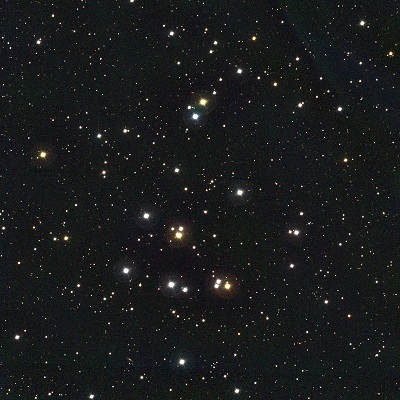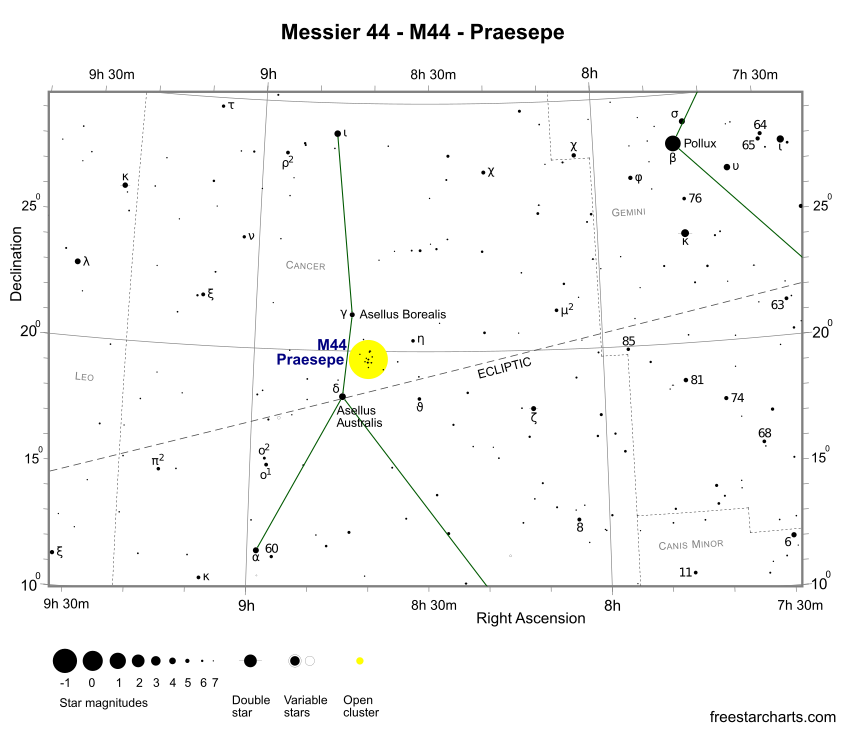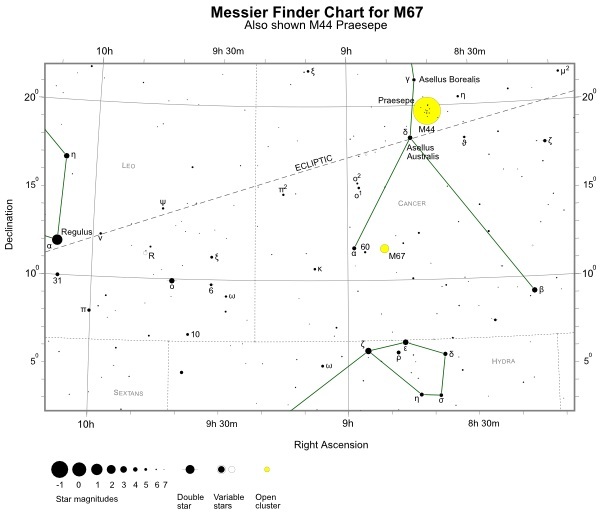M44, also known as the Praesepe or Beehive cluster, is a sprawling open cluster. It's the brightest and most prominent deep sky object in the constellation of Cancer. Visible to the naked eye under dark skies, the cluster appears like a large misty cloud covering over 1.5 degrees of sky. The brightness and size of M44 results from its close proximity to Earth; it lies a mere 577 light-years distant. Only the Hyades (at 153 light-years), Coma cluster (280 light-years), the Pleiades (M45) (425 light-years), Southern Pleiades (480 light-years) and IC 2391 (500 light-years) are nearer. Consequently, M44 is one of the brightest and largest objects of its type in the night sky.
The constellation of Cancer is a faint zodiac constellation that's bordered by much brighter Leo to the east and Gemini to the west. To the north is faint Lynx, with Canis Minor and Hydra located on the southern side. At the heart of Cancer is a grouping of four faint stars. They are Asellus Australis (δ Cnc - mag. +3.9), Asellus Borealis (γ Cnc - mag. +4.7), η Cnc (mag. +5.3) and θ Cnc (mag. +5.3). Of these, the brighter two are relatively easy naked eye objects, the fainter ones more difficult. Positioned at the centre of this grouping is M44. An alternative method of locating M44 is to imagine a line extending in a southeastern direction from Pollux (β Gem - mag. +1.1) for 37 degrees to Regulus (α Leo - mag. +1.4). M44 is positioned approximately at the mid-point of this line.
Nearly 2,000 years ago, the astronomer Ptolemy described M44 as "the nebulous mass in the breast of Cancer". It was Galileo who first telescopically observed the Praesepe. He did this in 1609 and was able to resolve 40 stars. Charles Messier added the item to his catalogue on March 4, 1769.
M44 is best seen from the northern locations during February, March and April.


Finder Chart for M44 - pdf format (credit:- freestarcharts)

Finder Chart for M67 (also shown M44) - pdf format (credit:- freestarcharts)
With an apparent magnitude of +3.7, the Praesepe is a relatively easy naked eye object that can be detected with even moderate amounts of light pollution. Under good conditions, it's clearly visible as a large patch of nebulosity covering 3x the diameter of the full Moon. Although better seen with averted vision, no stars are resolvable. Due to its large size, M44 is a superb binocular and small telescope object. When viewed through 10x50 binoculars it bursts into life, neatly filling a good proportion of the field of view with dozens of stars sprinkled throughout a hazy background.
The extra aperture and magnification range afforded by small or medium size telescopes bodes well when observing M44. With an 80mm (3.1-inch) scope, at about 30 to 40x magnification, the Praesepe is a wonderful sight with many stars arranged in pairs and triplets in equatorial and triangle shaped groupings. Most stars appear bluish-white, but there are at least four orange stars. Higher magnification reveals fainter background stars. In medium aperture telescopes, the Praesepe is still a superb cluster. The star colours are prominent but the cluster appears loose and tends to lose some of its awe. With a 200mm (8-inch) telescope, it doesn't take much magnification before it overflows the eyepiece field of view.
In total, M44 contains at least 350 members. The brightest member is ε Cnc, a mag. +6.3 hot blue-white A type star. There are at least another twenty stars brighter than mag. +8.0. Many different types of stars exist, including red giants and white dwarfs along with main sequence stars of spectral classes A, F, G, K, and M. Since M44 is located just north of the ecliptic plane, you often find the Moon or a planet weaving their way through the cluster.
M44 is a fantastic open cluster and one of the nearest open clusters to Earth. It's a large sprawling naked eye object that covers 3x the size of the full Moon and as a result is best seen with binoculars or a small telescope. Any optical aid will start to resolve the brightest stars with dozens visible in telescopes, although through larger instruments it appears loose and consequently some of its star appeal is lost.
M44 Data Table
| Messier | 44 |
|---|---|
| NGC | 2632 |
| Name | Praesepe |
| Object Type | Open cluster |
| Constellation | Cancer |
| Distance (light-years) | 577 |
| Apparent Mag. | +3.7 |
| RA (J2000) | 08h 40m 22s |
| DEC (J2000) | +19d 40m 19s |
| Apparent Size (arc mins) | 95 x 95 |
| Radius (light-years) | 8 |
| Age (years) | 650 Million |
| Number of Stars | 350 |
| Other Name | Beehive Cluster |